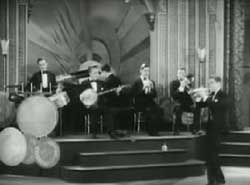 Red Nichols stands out front of his quintet playing the horn, a slim dapper young fellow, leader of Red Nichols & His Five Pennies (1929). Eddie Condon sits furthest forward with the band on a small stage, strumming a big banjo. Clarinetist Pee Wee Russell gets a fine lead solo.
Red Nichols stands out front of his quintet playing the horn, a slim dapper young fellow, leader of Red Nichols & His Five Pennies (1929). Eddie Condon sits furthest forward with the band on a small stage, strumming a big banjo. Clarinetist Pee Wee Russell gets a fine lead solo.
Though calmer than the ragtime of African American bands of the era, Red Nichols stands among the best as the first generation of white coopters of black music. This early Warner Brothers/Vitaphone short is a remarkable record of Red's band during its first flush of success.
After the initial ragtime piece, they next do a two-horn lead on a slow number. Those two instrumentals -- of "China Boy" & "Ida Sweet as Apple Cider" -- are followed by a vocal performance by Eddie Condon, the semi-standard "You're Nobody's Sweetheart" with Eddie giving it unusual inflections:
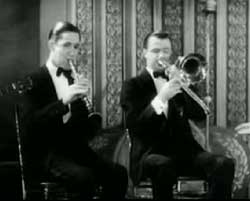 "When you walk. Down the Aa. Vennue/ Well yo' folks can't believe that it's you/ With your painted face. And your painted eyes/ Wearing a bird of paradise/ It all seems wrong somehow/ It seems so funny, you're nobody's sweetheart now." "When you walk. Down the Aa. Vennue/ Well yo' folks can't believe that it's you/ With your painted face. And your painted eyes/ Wearing a bird of paradise/ It all seems wrong somehow/ It seems so funny, you're nobody's sweetheart now."
Eddie returns to his chair, this time with banjo, & we get another ragtime instrumental called "Who Cares." But momentarily the banjo is set aside & Eddie takes to the floor again to sing beside Red on his trumpet:
"Won't you tell me who cares, when my heart is breaking/ And it's almost breaking, who cares/ Oh gee, that po' little me/ How often I get feeling sentimental/ No one gives a continental woncha-tell-me who cares..."
Eddie saunters amusingly back to the banjo & his chair as the final number bursts into raucous excitement, Red's horn leading first, then clarinet.
Overall, this is a superb one-reel musical short. The Roaring Twenties was simply an ace era for fun jazz that anyone with a beating heart would love.
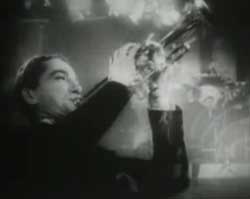 The punningly titled Paramount musical short Million Dollar Notes (1935) affects to be a performance for a small enthusiastic audience, simultaneously going out on the radio waves.
The punningly titled Paramount musical short Million Dollar Notes (1935) affects to be a performance for a small enthusiastic audience, simultaneously going out on the radio waves.
Red Nichols was not an innovator, but he was a great imitator. In the 1920s, white audiences were skittish of jazz which had the "taint" of being "race" music. Red like a lot of white musicians was absorbing the amazing innovations coming from the black community & then presenting them to white audiences.
Often bringing Harlem or New Orleans music to white folks meant watering it down, "whitifying" it, smoothing it out until it was milquetoast & still familiar to audiences that never heard real jazz.
But Nichols much of the time got it right, & his wholesome looking white band managed to be acceptible even when the music remained an "undamaged" close imitation of the gritty & real originals.
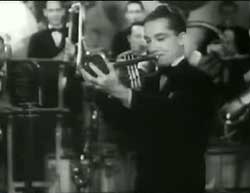 His horn solo for "St. Louis Blues" growls with tragedy & beauty. His horn solo for "St. Louis Blues" growls with tragedy & beauty.
Unfortunately, the unnamed vocalists were indeed a sorry case of whitification, & they destroy Red's efforts.
Red had recorded at least one of these songs with the vocal trio the Louisiana Rhythm Kings before 1930, but who these replacements in the mid-1930s were I can't identify. They're certainly not The Modern Mountaineers, let alone the Vera Van Trio or a "male trio" called the Wallace Sisters as proposed with wild absurdity here & there.
As he's the bandleader, though, he's to blame. How could he know to play it right instrumentally, & yet allow it to be sung so miserably?
Chances are it's a case of "baby steps" for audiences that might take something new in musicianship before they'll give up their crappy-ass collegiate singers.
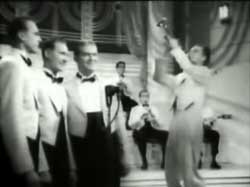 Sounding like white boogie woogie & nothing like dixieland, the crummy trio also sings: Sounding like white boogie woogie & nothing like dixieland, the crummy trio also sings:
"Rhythm of the Dixieland Band" that starts with the lyrics: "Did you ever hear the story of the dixieland band/ Only had five pieces & the music was grand."
Again, Red's cornet solo is nice, followed by a reasonable clarinet solo-moment.
Alas, all too soon the trio is harmonizing like a Yale glee club dragging it into suburbia even as the lyrics speak of Harlem, where anyone would rather be for a jazz night.
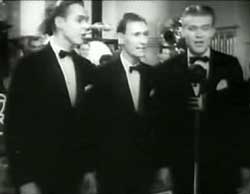 But the tune "Everybody Loves My Baby" is so good that even with a collegiate harmony rendition it comes off pretty damn good. But the tune "Everybody Loves My Baby" is so good that even with a collegiate harmony rendition it comes off pretty damn good.
Red's band is doing a superb job of it while this vocal trio manages some reasonable syncopation in their voices.
In fact, if I hadn't already heard them butcher "St Louis Blues" I might've mistaken them for a pretty cool group on the basis of this one number.
There's some nice-sounding "deet-deet-deeties" & "doot-doodlies" that seem to be these guys' sense of what scat should be, but it's melodic enough to be enjoyable.
And then one of them chants at Red: "Tell us red, what do you do, when you serenade your gal." He covers one ear & does a "deet-deet-deety" better than the trio, but wins an amusing rhyme; "Ah Red, please don't sing/ Pick up the horn & play that thing." And indeed Red closes the show with a great cornet solo.
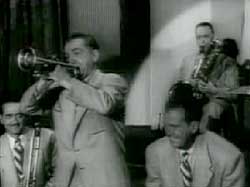 In the three-minite Snader telescription Three Blind Mice (1952), Red Nichols & His Five Pennies are literally performing the children's song.
In the three-minite Snader telescription Three Blind Mice (1952), Red Nichols & His Five Pennies are literally performing the children's song.
They start it off without much in the way of jazz but just a kiddy performance, & then suddenly bursting into a thrilling & humorous jazz rendition of the kids' song.
Nice solos in turn feature Rosie McHargue with clarinet, Red on trumpet, Joe Rushton with a gigantic bass sax (which gets the first applause from a small live audience), Bobby Hammock on piano, & King Jackson trumbone, all very nice. That's Rollie Culver on drums.
It's good, but when all is said & done it's all very cutesy & not all that dynamic as jazz per se.
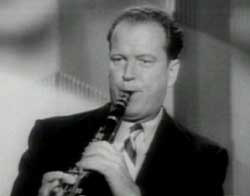 The Snader telescriptions record live performances by Red Nichol's & His Five Pennies in what was very nearly their final incarnation. They're old hands & very skilled, but seem to lack the dynamism of the band's younger years. They rely on the generic appeal of Dixieland jazz & do nothing particularly remarkable with it.
The Snader telescriptions record live performances by Red Nichol's & His Five Pennies in what was very nearly their final incarnation. They're old hands & very skilled, but seem to lack the dynamism of the band's younger years. They rely on the generic appeal of Dixieland jazz & do nothing particularly remarkable with it.
American Patrol (1951) is less Dixieland than most of their Snaders, starting off as a more ordinary patriotic parade tune & adding Dixieland licks as it goes along.
It starts off with a drum roll & you can see Rollie Culver's name on his bass drum head. Everyone's grinning as though they don't take this number at all seriously but do have fun with it. Clarinet solo from Rosie McHarque, then Red's cornet solo, adding up to a workmanlike arrangement with a lot of whimsy.
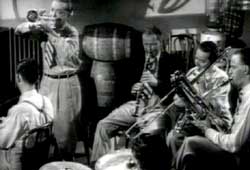 Adhering to their patriotic parade mood, another of their Snaders is the lamentable Battle Hymn of the Republic (1950). Although the dates on the films vary due to staggered release dates, they appear to have been made around the same time, in 1950, perhaps on two different days as there are a couple of stage sets used.
Adhering to their patriotic parade mood, another of their Snaders is the lamentable Battle Hymn of the Republic (1950). Although the dates on the films vary due to staggered release dates, they appear to have been made around the same time, in 1950, perhaps on two different days as there are a couple of stage sets used.
This one opens with an image of a painting of a charge into battle as the plaintive cornet has Red blowing the Glory Glory Hallelujah line, increasing its blues-jazz potential as various instrumentalists take turns being the leads.
The round of solos feature Bobby Hammock on piano, then Rosie's clarinet, then a drum break as the number increases pace & becomes much more a generic Dixieland performance, though Joe Rushton's sax solo is a moment of distinction.
It's actually one of the better arrangements among the Snaders done by Red & his boys, but even so, there's a generic tone & it becomes obvious why Red's band had more slumps than big successes along their long career.
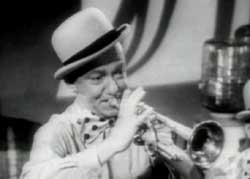 Yet another marching tune, Entrance of the Gladiators (1952) will be recognized by most folks as the music to which clowns run to the center of the big top & begin their antics.
Yet another marching tune, Entrance of the Gladiators (1952) will be recognized by most folks as the music to which clowns run to the center of the big top & begin their antics.
The tune will be recognized as a commonplace circus theme for when the clowns pour into the ring. Red & his boys are beginning to seem like All Novelty All the Time, & No Substance.
Given that Red Nichols the Five Pennies were once upon a time a leading Dixieland jazz quintet with originality to go with their liveliness, it's kind of sad to see them as high camp playing the themesong for Bozo the Clown cartoons. Nice bowler hats they're all wearing, though.
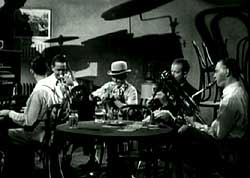 The stage set for this Snader looks like a barroom with tables & chairs & a water cooler up against the wall (there were wooden beer kegs against the wall in Battle Hymn & Entrance of the Gladiators), & curious film noir shadows inapropos of the other two films done on this set, but suited to Back Room Blues (1950).
The stage set for this Snader looks like a barroom with tables & chairs & a water cooler up against the wall (there were wooden beer kegs against the wall in Battle Hymn & Entrance of the Gladiators), & curious film noir shadows inapropos of the other two films done on this set, but suited to Back Room Blues (1950).
It must be after hours because only the chairs used by the band are down; the other visible table has its chairs upside down casting shadows on the back wall. The band's table has a few beers setting on it, & a deck of cards arranged as for a half-finished game of solitaire.
The title of Back Room Blues suggests this is a backroom at the bar, perhaps for special intimacy of the band or for card-playing patrons, with an upright piano in the confining space.
The number starts out with Bobby Hammock on piano leading a true blues piece, & its right off the bat much the best of the five Red Nichols Snaders, as well as the only one that doesn't have that air of just goofing around.
Red proves he really can still play seriously if he decides to, & each solo that follows (King Jackson's slide trumbone, Joe Rushton's bass sax) is charged with emotion.
copyright © by Paghat the Ratgirl
|
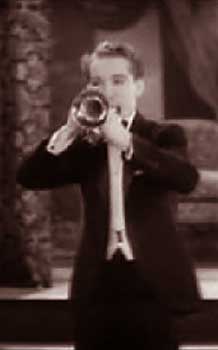

 "When you walk. Down the Aa. Vennue/ Well yo' folks can't believe that it's you/ With your painted face. And your painted eyes/ Wearing a bird of paradise/ It all seems wrong somehow/ It seems so funny, you're nobody's sweetheart now."
"When you walk. Down the Aa. Vennue/ Well yo' folks can't believe that it's you/ With your painted face. And your painted eyes/ Wearing a bird of paradise/ It all seems wrong somehow/ It seems so funny, you're nobody's sweetheart now."
 His horn solo for "St. Louis Blues" growls with tragedy & beauty.
His horn solo for "St. Louis Blues" growls with tragedy & beauty. Sounding like white boogie woogie & nothing like dixieland, the crummy trio also sings:
Sounding like white boogie woogie & nothing like dixieland, the crummy trio also sings: But the tune "Everybody Loves My Baby" is so good that even with a collegiate harmony rendition it comes off pretty damn good.
But the tune "Everybody Loves My Baby" is so good that even with a collegiate harmony rendition it comes off pretty damn good.



